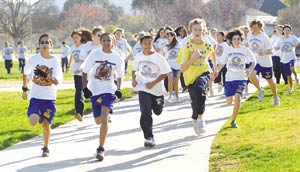All the sweating on school playgrounds and inside school gyms
seems to be making a difference for local kids, burning calories
and trimming students’ waistlines as they become more fit.
MORGAN HILL
All the sweating on school playgrounds and inside school gyms seems to be making a difference for local kids, burning calories and trimming students’ waistlines as they become more fit.
More seventh and ninth grade students in the Morgan Hill Unified School District are considered in better physical shape than students in those grade levels in Santa Clara County or in the state, according to results released by the California Department of Education earlier this month.
But fifth graders lagged just slightly behind the county and the state, said Esther Corral-Carlson, coordinator of assessment for the district.
The 2006-07 California Physical Fitness Report prepared by the California Department of Education gives the results in six physical fitness areas for fifth-, seventh- and ninth-grade students.
The test measures students’ aerobic capacity, body composition, abdominal strength, trunk extensor strength, upper body strength and flexibility. Students who meet five of the six criteria are considered proficient, or physically fit.
For each of these criteria, there are different exercises to measure based on a student’s age and sex. For example, a 13-year-old female must complete between 18-32 curl-ups to be scored as physically fit in the abdominal strength area. A 13-year-old male must complete between 12-25 push-ups to pass the upper body strength portion of the test.
Districtwide, 48.9 percent of fifth graders were considered physically fit, which is a little bit below the state and county, yet for fifth grade there was a slight increase over a three-year period, Corral-Carlson said.
At the seventh grade level, 63 percent were physically fit, which is almost six percent above the state and four percent above the county. At the ninth-grade level, 67 percent scored proficient, which is 10 percent above the state and eight above the county.
Tony Goble, Live Oak High School’s P.E. department chair, said he tries to help students get ready to pass the test and understand that physical fitness is a lifestyle choice that goes beyond the school years.
“Over the years since the ninth grade has come to the high school, I have taken that on, motivating the kids through practicing what we teach,” he said. “For me, it’s the whole fitness part, the whole P.E. program. I run the mile with these students, every period, and try to show them that it is important.”
Nutrition and other aspects of fitness are a part of the program, he said.
The state agrees, and laws prohibiting the consumption of junk food and sodas at school have gone into effect. Vending machines on Morgan Hill campuses that used to contain soda are now stocked with water, juice and sports drinks. Cafeterias are planning their menus based on lower fat content. And classroom celebrations – birthday parties, holidays – are healthier, with an emphasis on foods like carrots and fruit instead of cupcakes and cookies.
Goble said he has also designed a conditioning program to gradually get ninth graders ready for the exercises required during the annual physical fitness test, but he is careful to make it clear that hard work and making a sincere effort are what is important to him.
“If I have a student of a certain body type who knows from the beginning that they aren’t going to be able to run the mile in the required time, for example, instead of having them be negative and defeated by that, I let them know that if they work to improve, that if they really try, that’s what counts with me in my class.”
Corral-Carlson said the district last year reviewed last year’s report with a certificated P.E. instructor and a group of teachers, and a plan was created to help students increase their level of fitness, particularly at the fifth-grade level.
Students in the district’s elementary schools do not have physical education teachers. Though they have regular P.E. schedules, it is the classroom teachers who lead them in their exercises. These teachers may not have special training in physical education, Corral-Carlson said.
Once again, she added, the district will meet with a P.E. teacher from one of the secondary schools and create a plan. The teacher will then train one fifth grade teacher at each of the elementary schools, and that teacher will be the lead teacher at the school who trains the other fifth grade educators. Part of the training includes the proper administration of the physical fitness test, she said.
Students in the seventh grade have P.E. every day as one of their regular middle school classes in their six-period day. Ninth graders typically also choose PE as one of their six classes, as two years of P.E. in high school are a graduation requirement.
“While I’m pleased these numbers are moving in the right direction,” State Superintendent of Public Instruction Jack O’Connell said, “this annual fitness test serves as an important reminder to all of us that the majority of our students are not in good physical shape. Studies show that students who are physically fit are not only healthier but do better in school. It is up to all of us to provide ample opportunities for our students to get motivated and get moving.”
Statewide, nearly 40 to half of state students failed the most aerobic capacity portion of test and how nearly 30 percent of fifth- and seventh-graders statewide are weak and winded when they’re asked to run a mile in a decent amount of time.
Countywide, nearly 53 percent of fifth-grade students are considered physically fit, 59 percent of both seventh-graders and ninth-graders meet the criteria, which requires that students are in the “healthy fitness zone” in five of the six areas.








